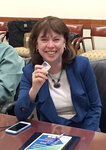

FRIDAY, April 21 — When Margaret Weitekamp isn’t handling genuine space travel artifacts like pressurized suits and lunar landers, she gets to play with toy astronauts, aliens, space ships and ray guns all day. Nice work if you can get it.
The curator of the Space History Department at the Smithsonian Institution's National Air and Space Museum, in Washington, D.C., will visit MSU’s Abrams Planetarium Wednesday to share some of the 6,000 or so stories embedded in the museum’s collections.
The visit, sponsored by the MSU Museum as part of the university’s month-long Science Festival, sets the stage for state-wide Astronomy Night on April 29.
It’s play, but it’s serious play. Weitekamp is a professor of history on a mission to unpack the cultural and historical forces that drive the American obsession with space travel, real and imagined.
Her new book, “Space Craze,” takes the reader behind the scenes of the museum, from the early sci-fi visions of H.G. Wells to the thinly disguised Wild West adventures of Buck Rogers and Flash Gordon to Apollo, “Star Trek,” SpaceX, Afro-Futurism and beyond.
“It’s the book that I wish someone else had written before I got this job,” she said, “to help me make sense of all these things.”
Weitekamp didn’t set out to be our national curator of space tchotchkes.
“I had no idea a job like this existed,” she said. “I thought I was going to be a college professor, and I was, for a few years.”
She spent a lot of time at the NASA History Office while teaching at Cornell University and researching her doctoral dissertation on the history of a women’s astronaut testing project dating from the late 1950s.
As it happens, NASA’s D.C. digs are a lunar-gravity hop away from the National Air and Space Museum.
The museum’s collection and its hard-working curators and scholars impressed Weitekamp, but she didn’t know there was such a thing as “curator for the social and cultural history of space flight collection” until the job opened up a few years later.
“I was doing a class about spaceflight imagination and real space history, teaching about Buck Rogers, Flash Gordon, ‘Star Wars’ and ‘Star Trek,’ so it was right up my alley,” she said.
Now she walks by the original starship Enterprise from “Star Trek” and the scorched command module from the Apollo 11 moon shot on her way to the office.
The wildly popular museum gives her a much bigger platform than a college classroom.
“A million people a year come though the room, for about 20 to 30 minutes, and they want to be there and learn something,” she said. “Or most of them do.” (She tries to make it interesting for the people “who got dragged along” as well.)
The collection runs the gamut from a well-loved Mercury capsule-shaped cookie jar to a rubber fan-made Mr. Spock ear and a charm bracelet jingling with tiny replica spacecraft.
Many of the objects represent American enthusiasm, creativity and ingenuity at their best. Weitekamp brought in the personal collections of Neil Armstrong and Sally Ride after they died. She’s worked with many NASA luminaries, including Kathryn Sullivan, the first American woman to walk in space.
The collection is still growing. Weitekamp doesn’t have a buying budget, so she relies on donations.
“It could be people who have a relative that worked on the Apollo program or the shuttle program, and they’ve found things when they’re cleaning out their aunt’s or uncle’s house,” she said.
Other pieces reflect the same old conflicts that have played out on solid Earth for the past hundred years.
There are plenty of space travel play sets with no women or non-white figures in sight, often battling vaguely swarthy or Asian-looking aliens. The frontier-taming trope persists all the way to toys that tie in with first “Star Wars” movie, with its infamously nearly all-white cast.
The most abundant cultural item in the collection is sadly predictable: ray guns, ray guns, ray guns.
Weitekamp isn’t shy to point out the obvious links between pervasive gun culture in America and the astonishing ubiquity of ray guns in science fiction. She points out that early sci-fi hits like “Buck Rogers” and “Flash Gordon” were little more than zapped-up Westerns, complete with a hostile frontier, fragile women to protect and no end of interplanetary indigenous people to subdue.
Even “Star Trek,” with its optimistic and inclusive vision of the future, had its famous hand phasers — and they weren’t always set on stun. (Series creator Gene Roddenberry pitched the show to CBS as a “wagon train to the stars.”)
But all of that is clearly changing, both in reality and science fiction, Weitekamp said. NASA’s Artemis moon shot, set for 2024, aims to put the first African-American and the first woman on the moon. A raft of new space-themed shows, inside and outside of the “Star Trek” and “Star Wars” galaxies, proudly prioritize gender, race and ethnic diversity and prefer emotion- and science-based story arcs over endless war on the frontier. All those ray guns are finally starting to look more like antiques than objects from the future.
On the other hand, Weitekamp’s analysis makes you look twice at a photo of Amazon mogul Jeff Bezos, sporting a cowboy hat at the launch of the New Shepard space shot in July 2021.
In “Space Craze,” Weitekamp lays out an all-American buffet of rampant ego, reckless daring, humanist idealism and humble curiosity.
“What strikes me now, after 20 years working in this field, is how much space flight continues to be a really powerful thing in American culture,” she said. “That’s because it’s a reflection of who we Americans like to think we are, and want to be, but that carries with it all the complications of who we actually are.”
Support City Pulse - Donate Today!
Comments
No comments on this item Please log in to comment by clicking here